1 of 48 1971 HEMI® ‘Cuda
— E74 HEMI® ENGINE OPTION
— A34 SUPER TRACK PAK OPTION
— EV2 TOR-RED HIGH IMPACT PAINT
“The Rapid Transit System” was how the 1971 performance cars from Plymouth Division were introduced inside the pages of the RTS brochure: “It’s more than just a big motor, fat tires and a straight line. Almost anybody can build a machine like that. What the system does differently, is come through with everything connected with performance. Puts it all together. And winds up producing some of the best stockers that have ever rolled off an assembly line. The Rapid Transit System 1971. It was inevitable. It’s here. And it’s coming through for you.”
And in the case of this 1971 HEMI engine-powered ‘Cuda, it was more of a bare-bones performance car that seemed to be ordered especially for drag racing or street racing more than anything else! This Tor-Red-hued example came with 727 TorqueFlite®, power steering and AM radio as options. Save for a repaint, this is a true “survivor” and rolling time warp from 1971.
HEMI ENGINE UNDER THE HOOD
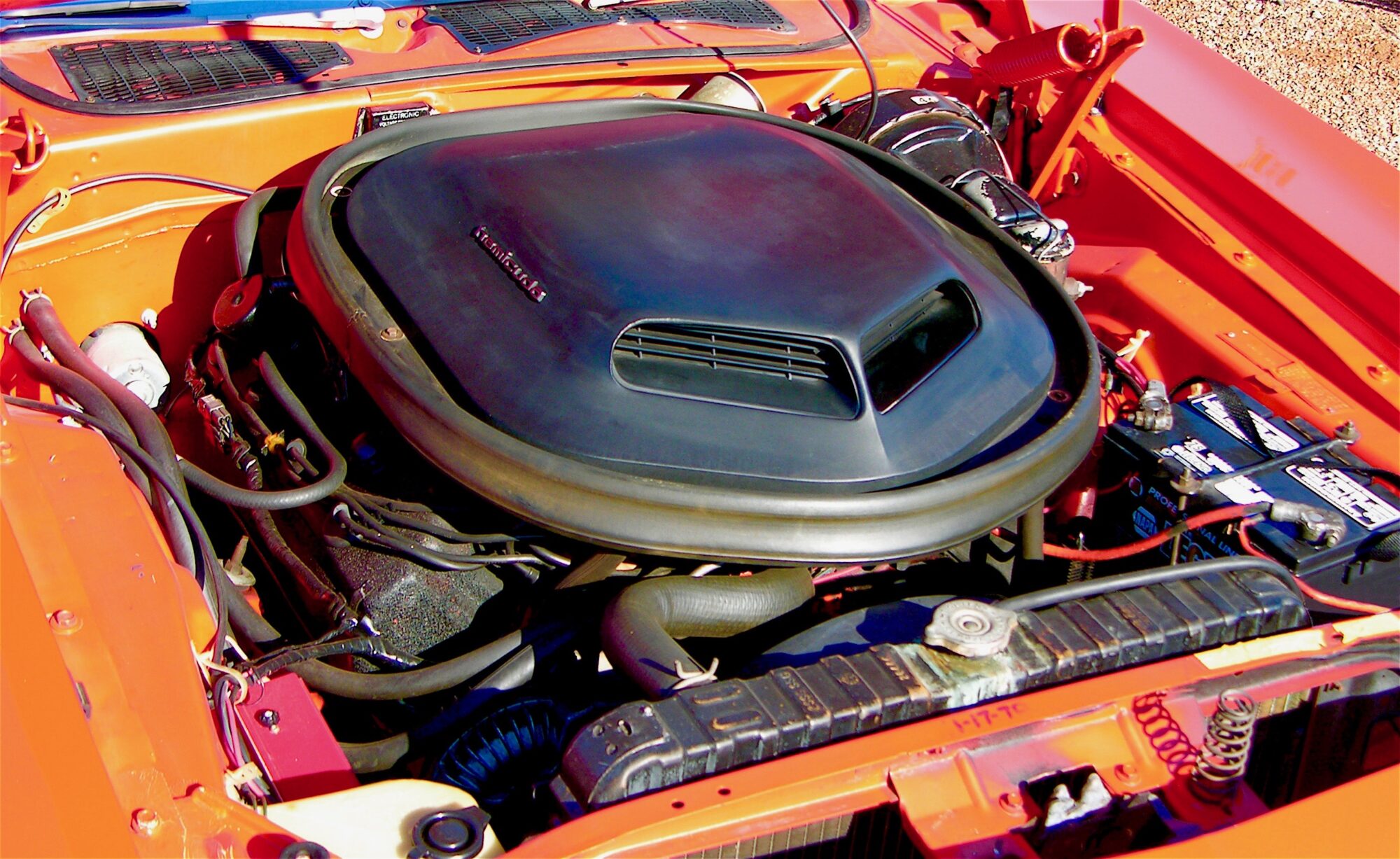
426 HEMI: Hemispherical combustion chambers, huge valves, massive ports and bore: 4.25-inch, stroke 3.75-inch. 4.80-inch bore spacing. 490 lbs-ft torque at 4,000 rpm. Gross horsepower 425 at 5,000 rpm. 10.2:1 compression, 2 4-bbl Carter AFB (aluminum four barrel) carburetors, dual-point ignition. High-lift, long duration camshaft (.484″ I / .475” E lift, 284-degree duration). 1971 was the last year for production of this iconic powerplant. Only 48 Plymouth ‘Cuda TorqueFlite-equipped cars were built in 1971 with the HEMI engine.
SHAKER HOOD STANDARD EQUIPMENT
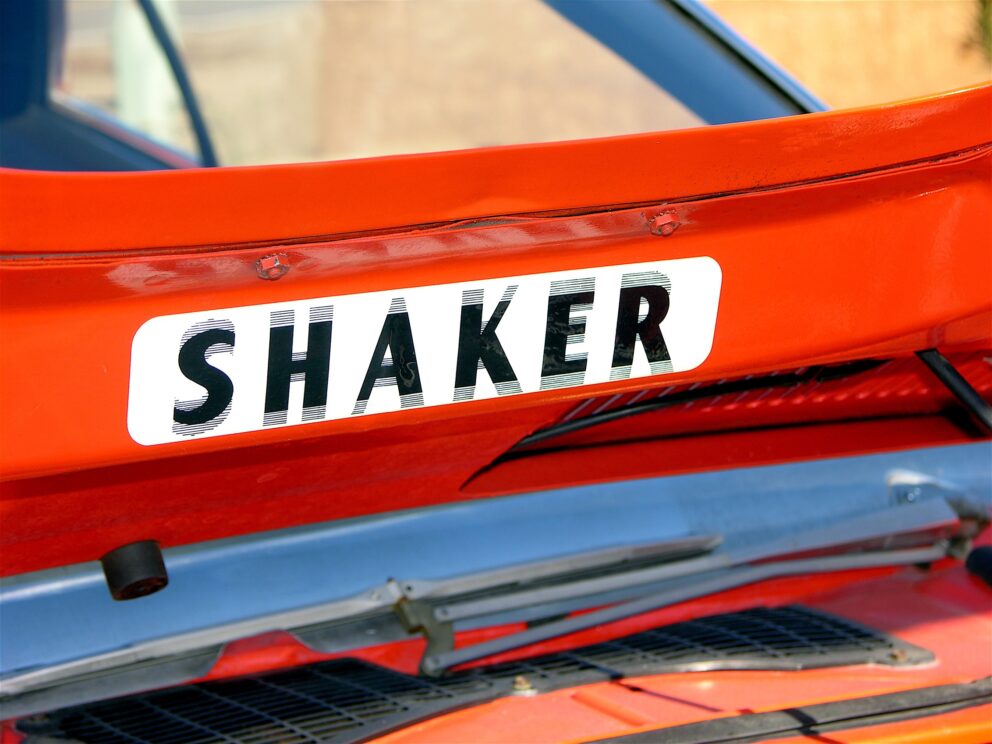
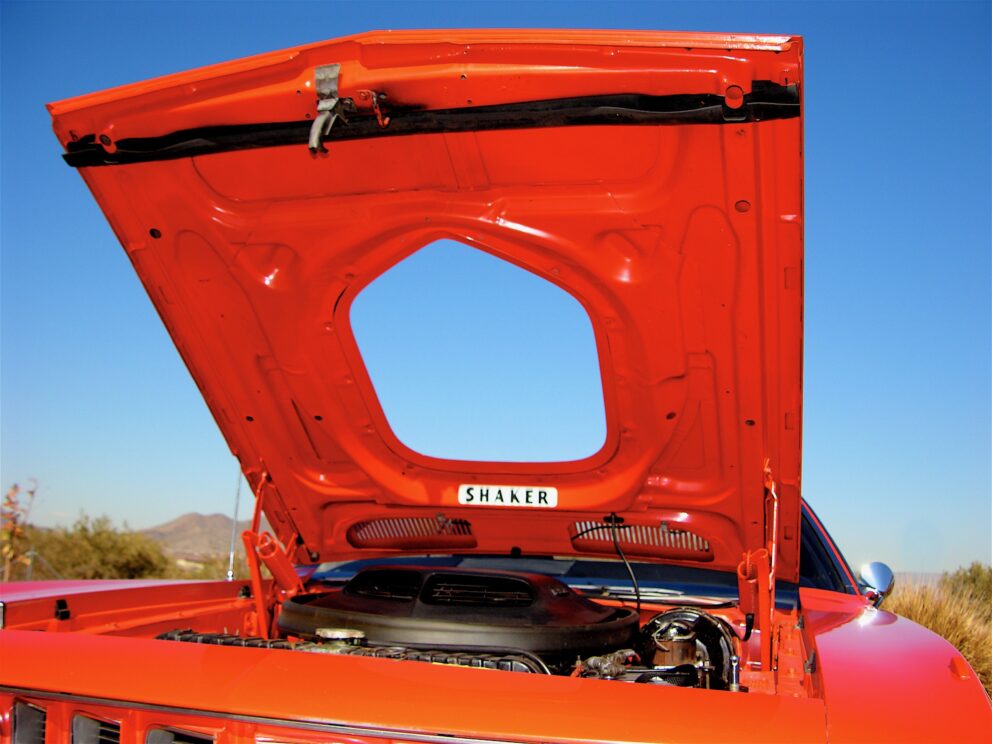
The Shaker hood and scoop is just one of the features that makes this E-body car so cool!
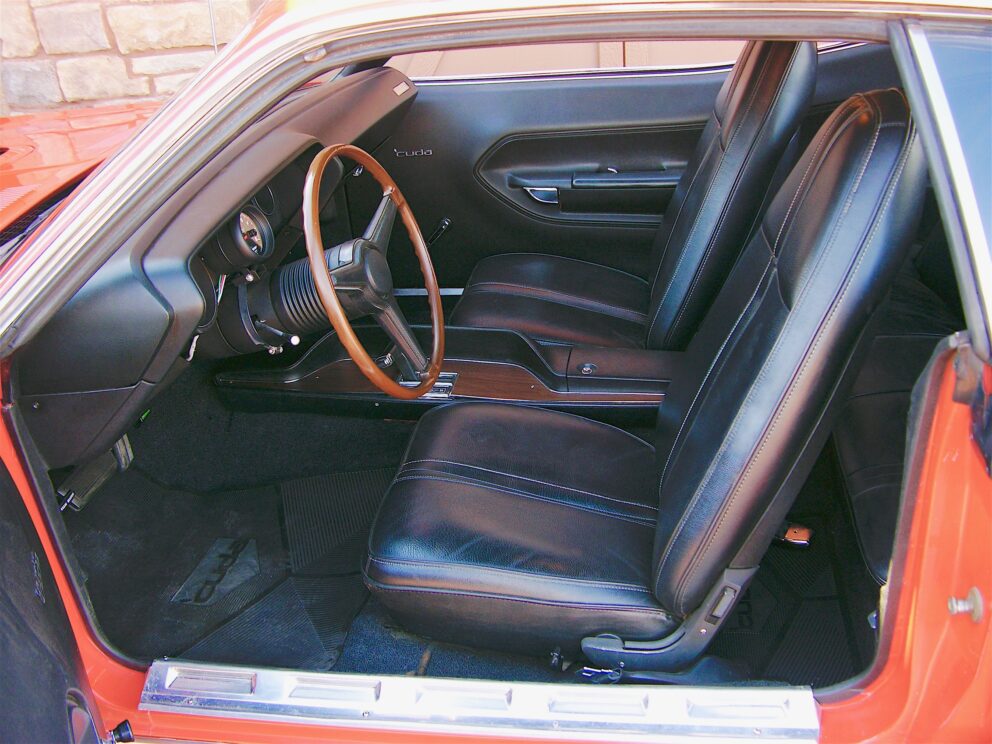
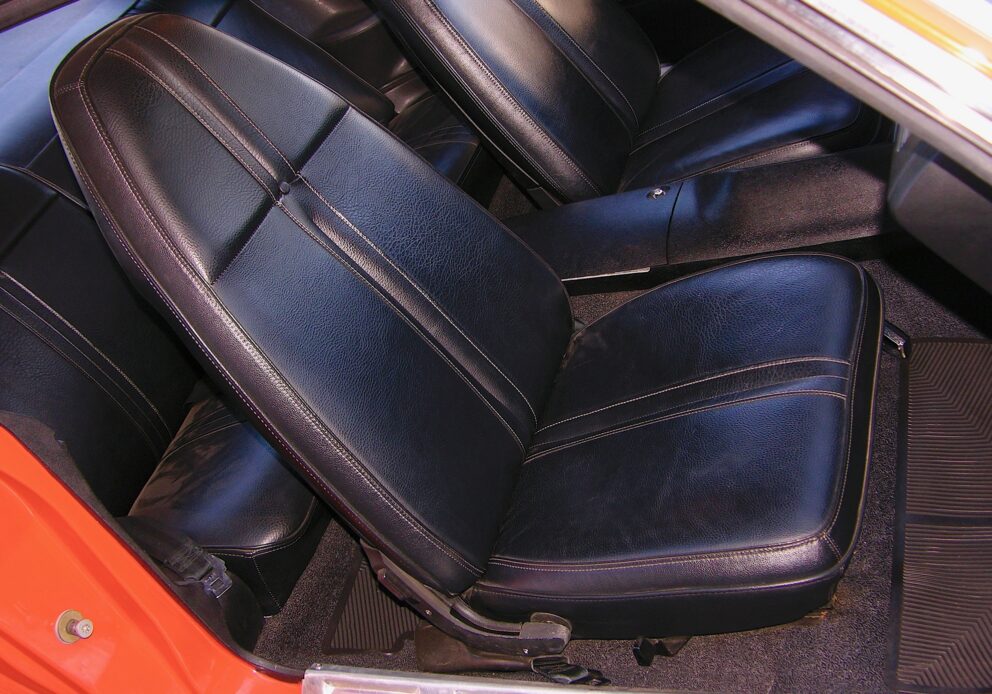
Third-generation Barracudas featured sculptured interiors and the door panels were constructed using polypropylene plastic material, said to look like a “space ship cabin” by some of the motoring press at the time! On this car, an aftermarket Autometer 8K electric tachometer was added to the steering column. Just 19,250 miles on the odometer and in near-new condition inside. No leather or fancy upholstery on these buckets, a bare-bones interior.
SLAP-STICK SHIFTER
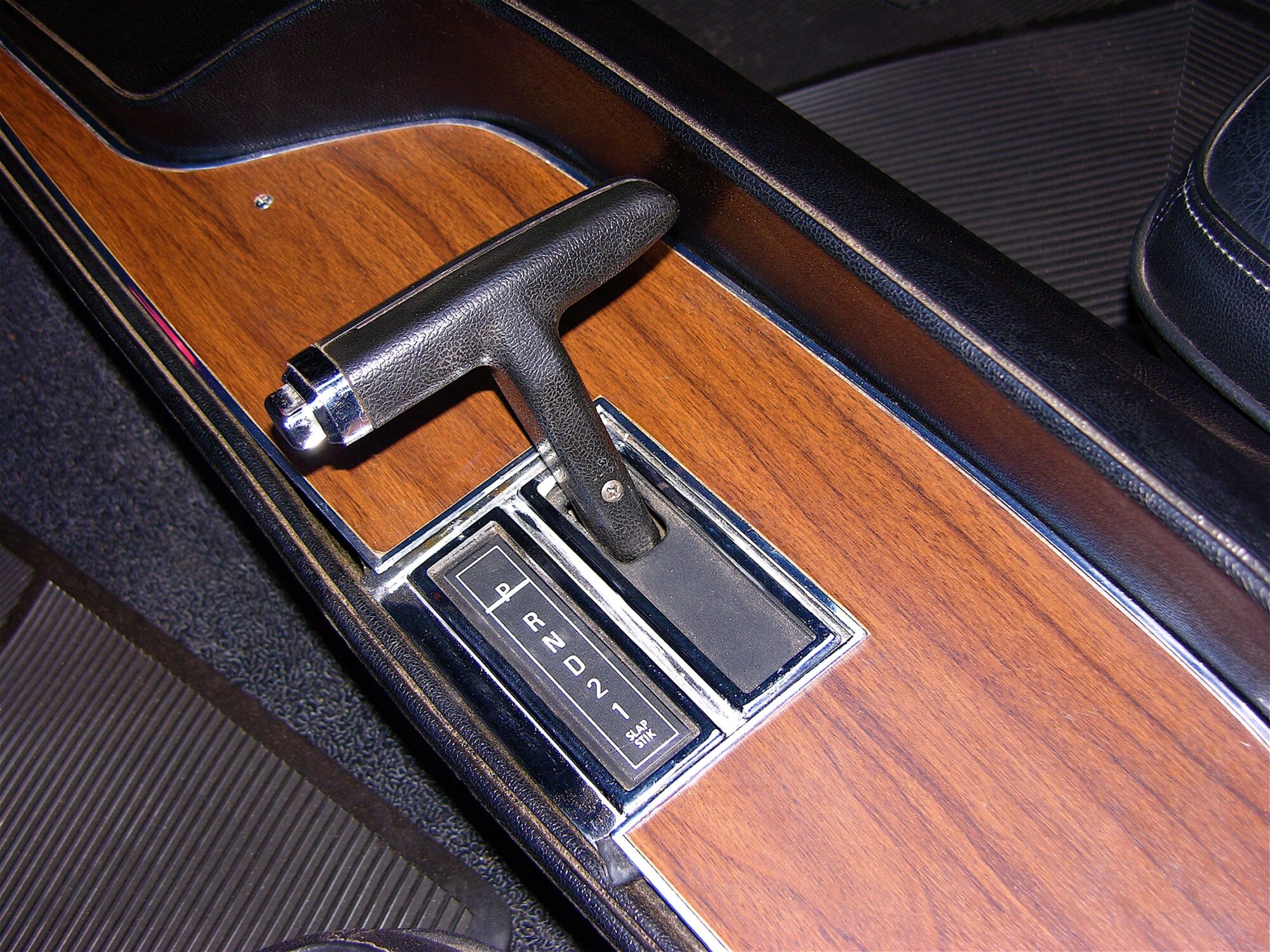
Mounted in the optional center console is the T-bar shift handle-equipped slap-stick shifter, featuring special linkage for the quicker, sure gear changes on the TorqueFlite automatic.
TAIL OF THE FISH
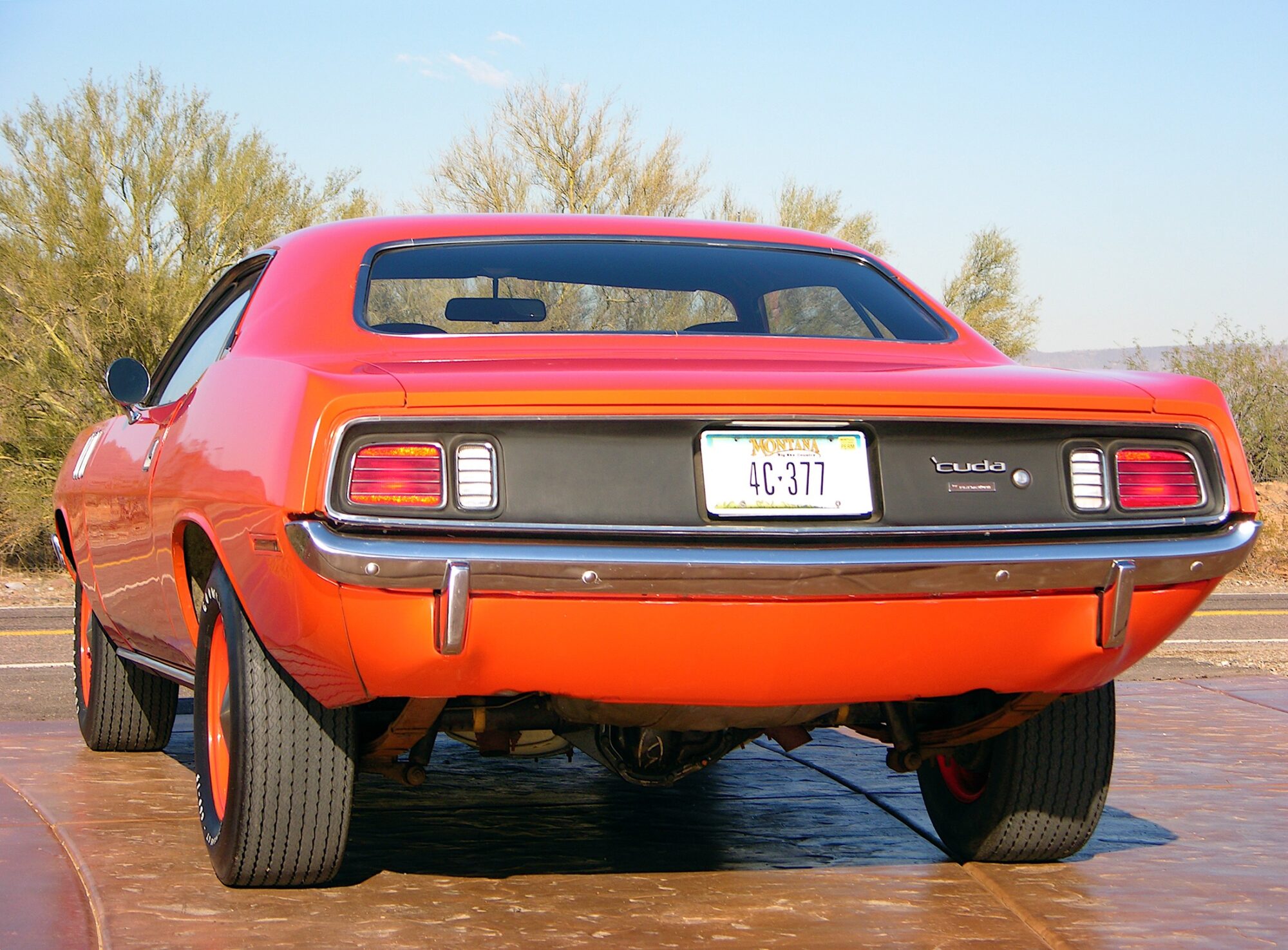
Rear view shows how the small bumperettes on the rear bumper line up perfectly with the lines of the leaf springs, which was no accident. Because the E-body designers chose to run the traditional B-body rear suspension (which included full-length leaf springs), the extra length of the rear spring portion had to be somehow hidden into the design of the rear of the car. To hide the springs, the rear valance panel had bulges in them and that is where the decorative bumperettes were placed.
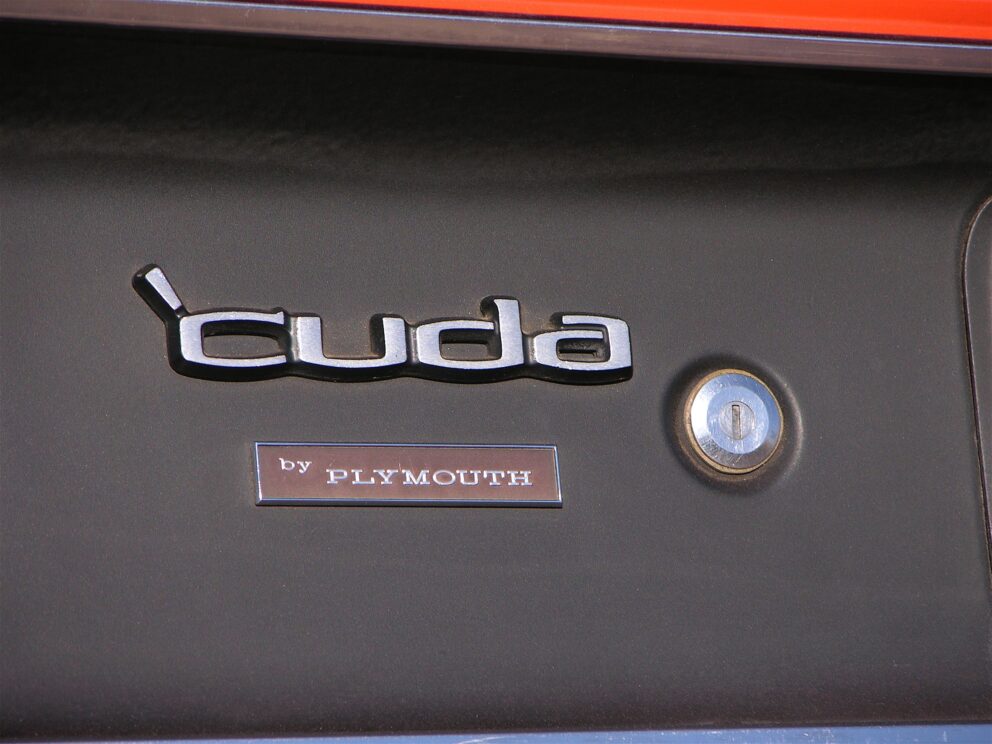
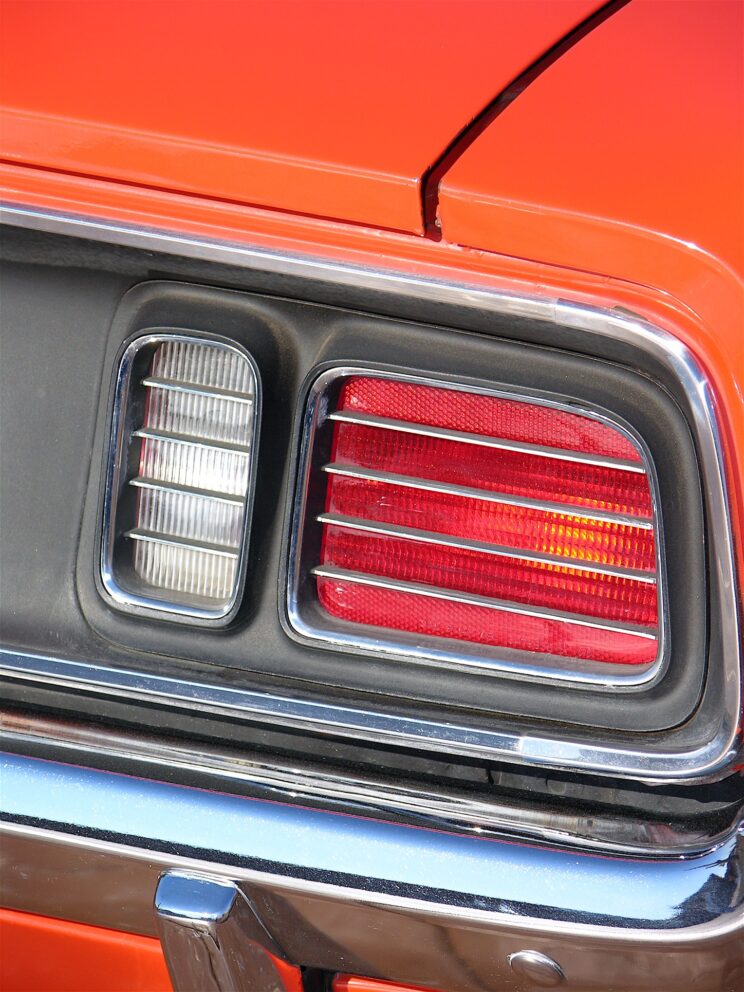
For 1971, the ‘Cuda emblem on the rear facing panel was joined by this “by PLYMOUTH” insignia. The 1971 taillights were restyled to provide a different rear view as compared to the 1970 cars.
LAST YEAR FOR 426 GEN II HEMI ENGINE
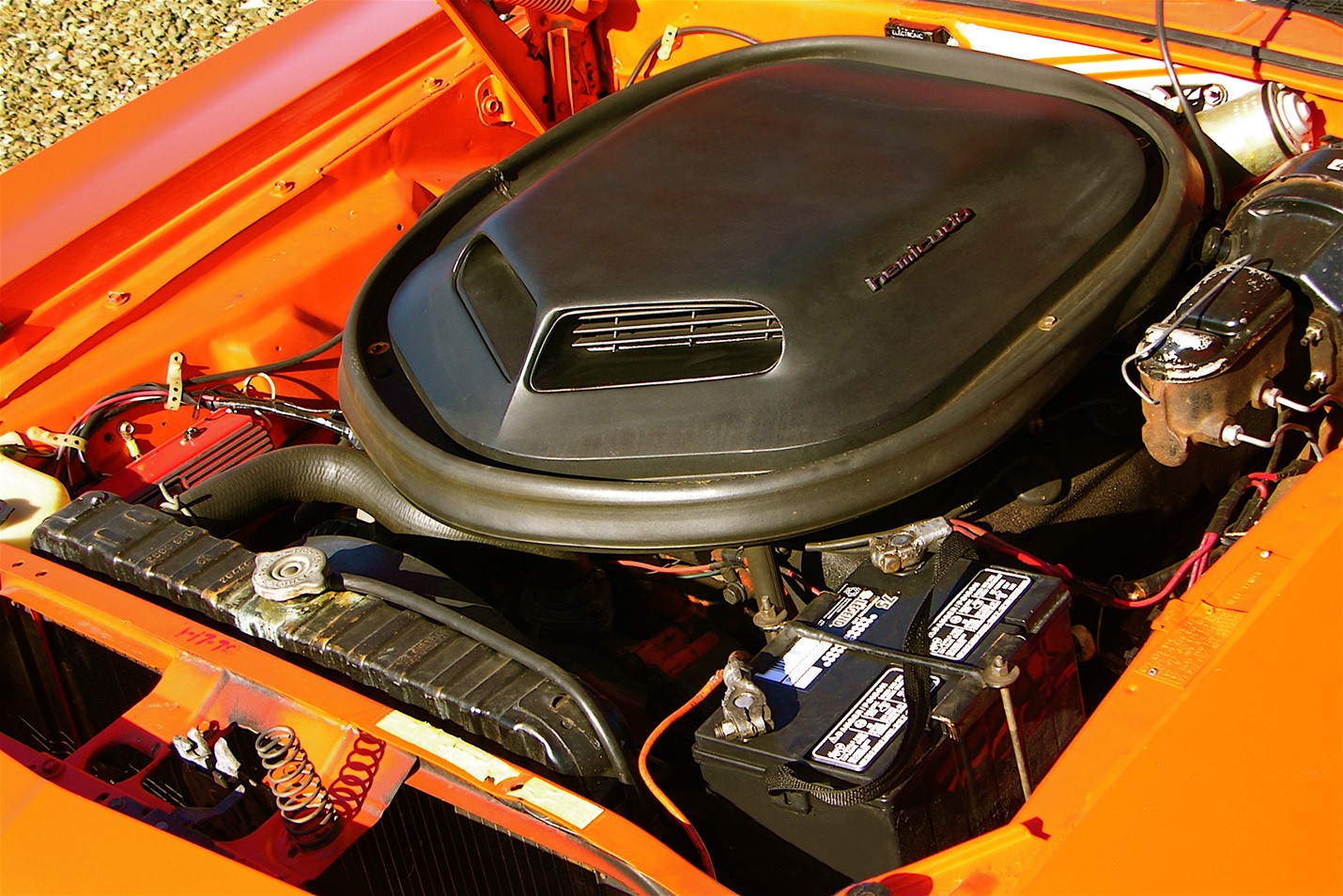
Model year 1971 saw the end of the production 426 HEMI engine, and while the gross horsepower figure was listed at 425, same as previous Street HEMI engines from 1966-on, this model year had an “SAE net horsepower” listing of 350 for the HEMI engine.
QUAD HEADLIGHTS FOR ’71
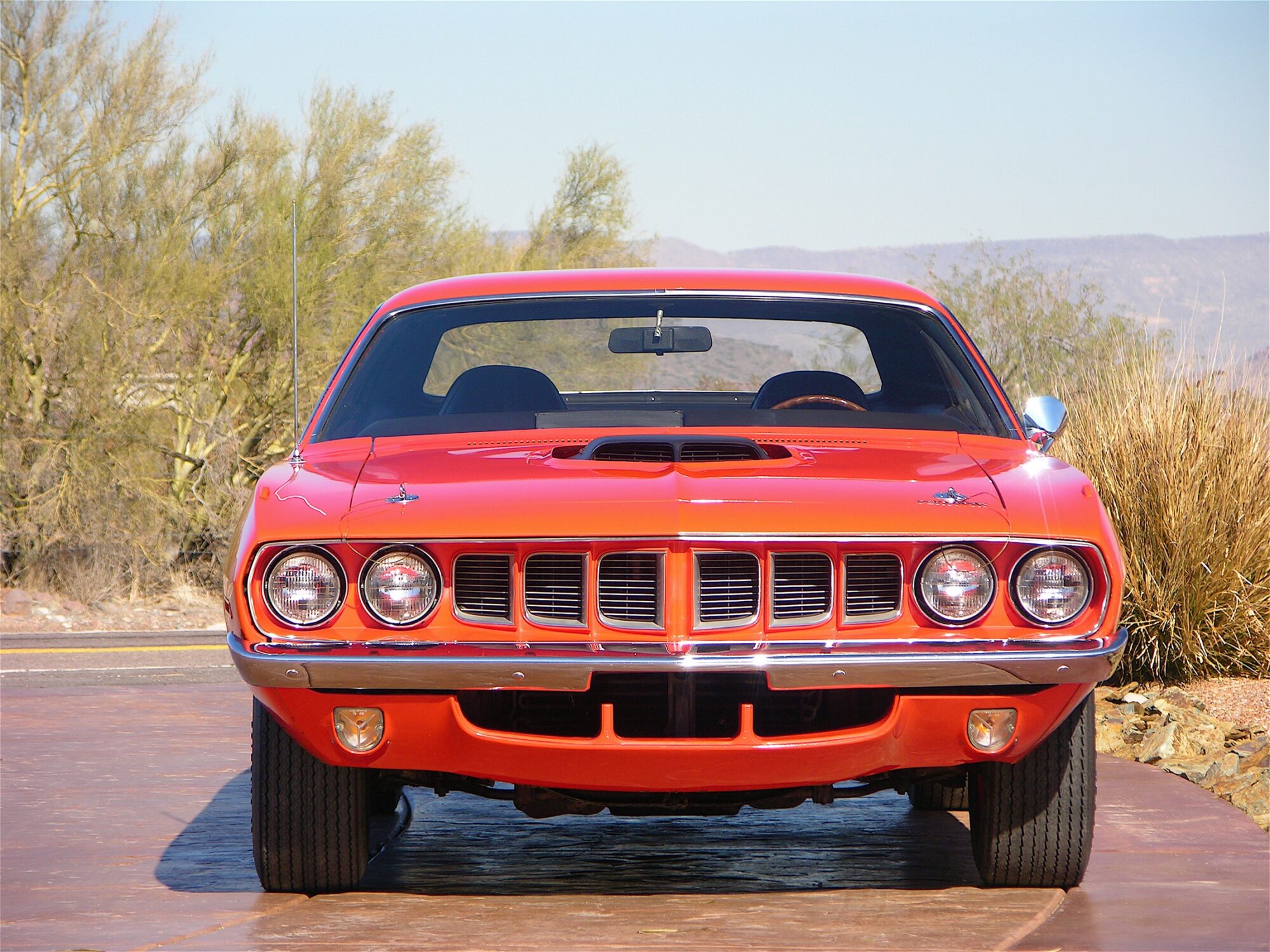
The stylists revised the front end of the Barracuda line for ’71, a new vertical-sectioned recessed grill with six “gill” openings, also four headlights replacing the 1970 single headlights. ‘Cuda models featured body-color grille and HEMI engine-powered cars had the Shaker as standard equipment, optional on 340, 383 and 440 ‘Cuda models.
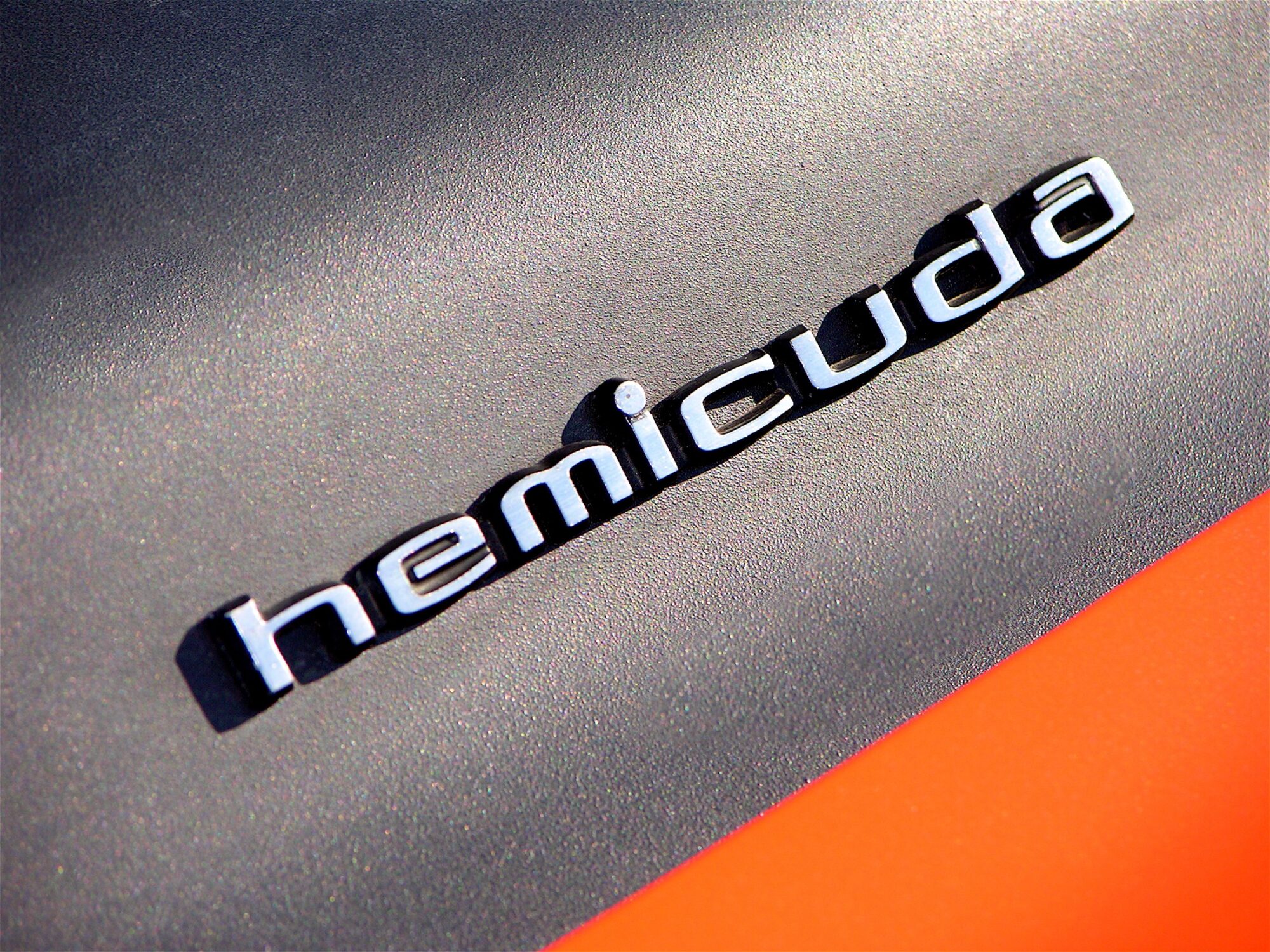
These small emblems on the Shaker were the only indications of what lurked under the hood…
DOG DISH HUB CAPS
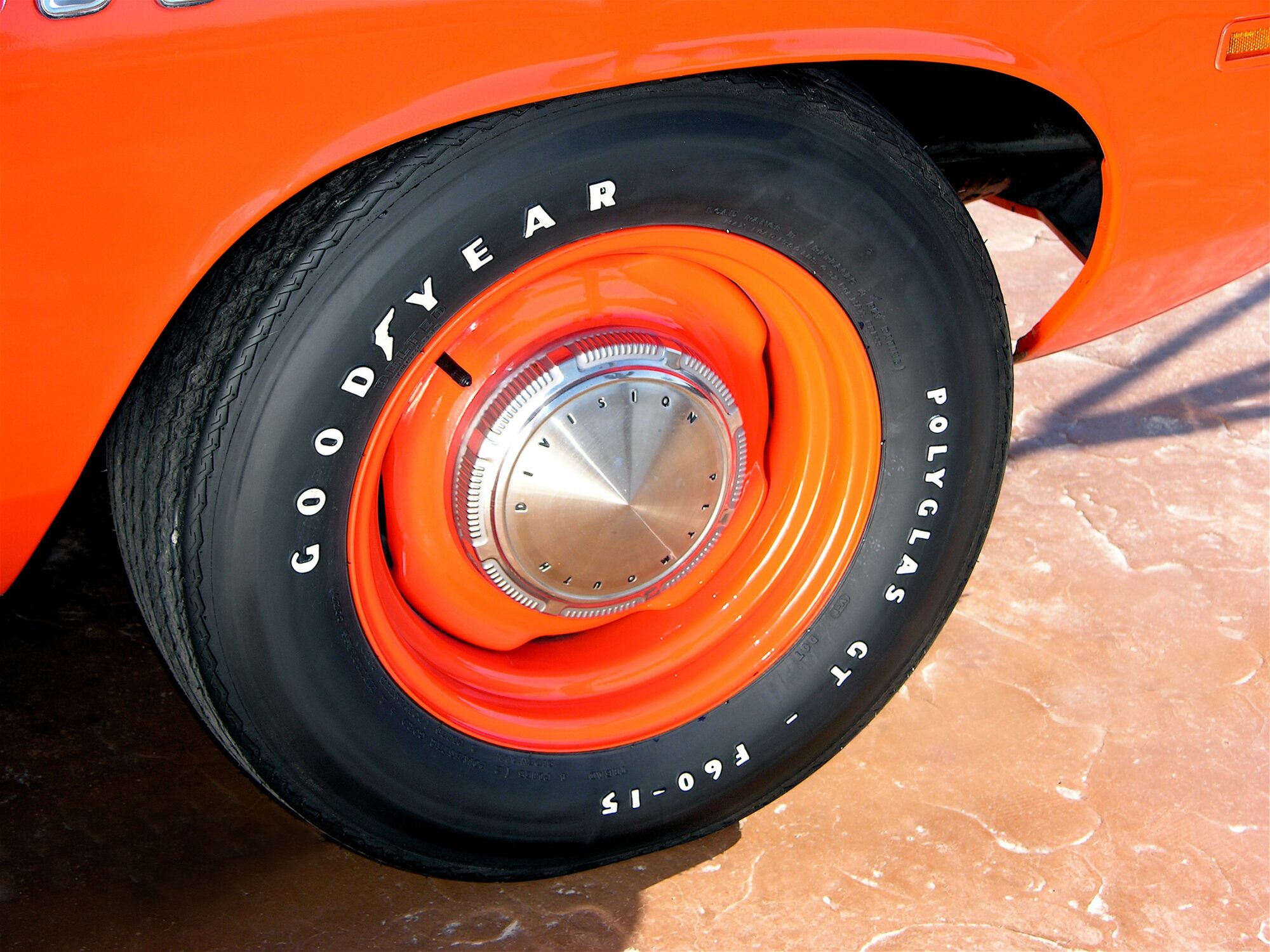
The rubber used on HEMI engine-powered E-body cars were Code “U84” which were Raised White Letter Goodyear Polyglas GT sized F60-15. This car rolled out of the factory with body-color steel wheels and the standard hub caps (AKA dog dish). Oftentimes, buyers opted for the least expensive wheel option because one of the first items added were aftermarket “mag” wheels.
BODY LINES
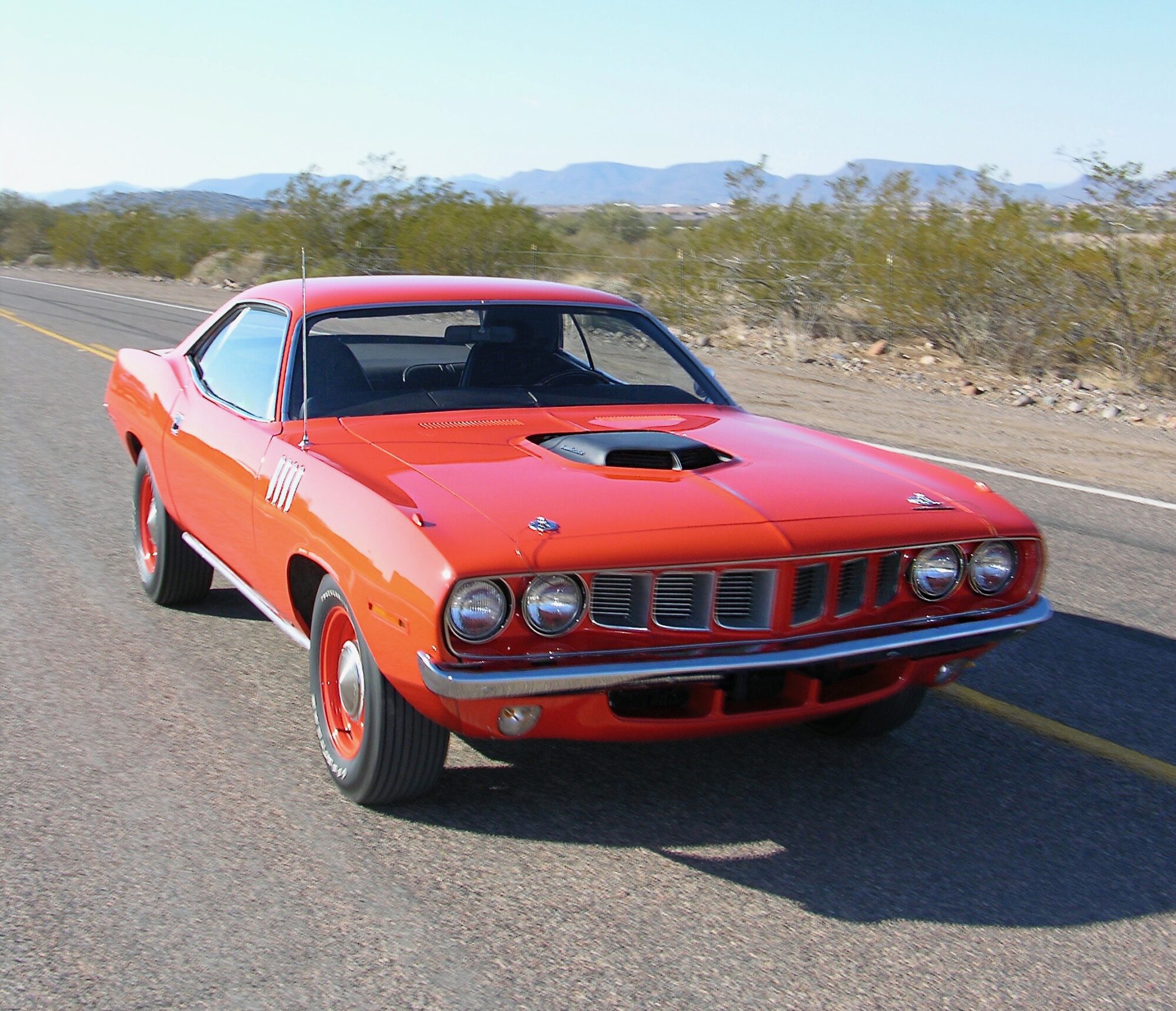
The iconic body design of the third-generation Plymouth Barracuda (1970-74) was penned by John Herlitz, who became known as a master of conceptualization and execution. The long nose/short deck layout was an important ingredient to what made these cars so visually appealing.
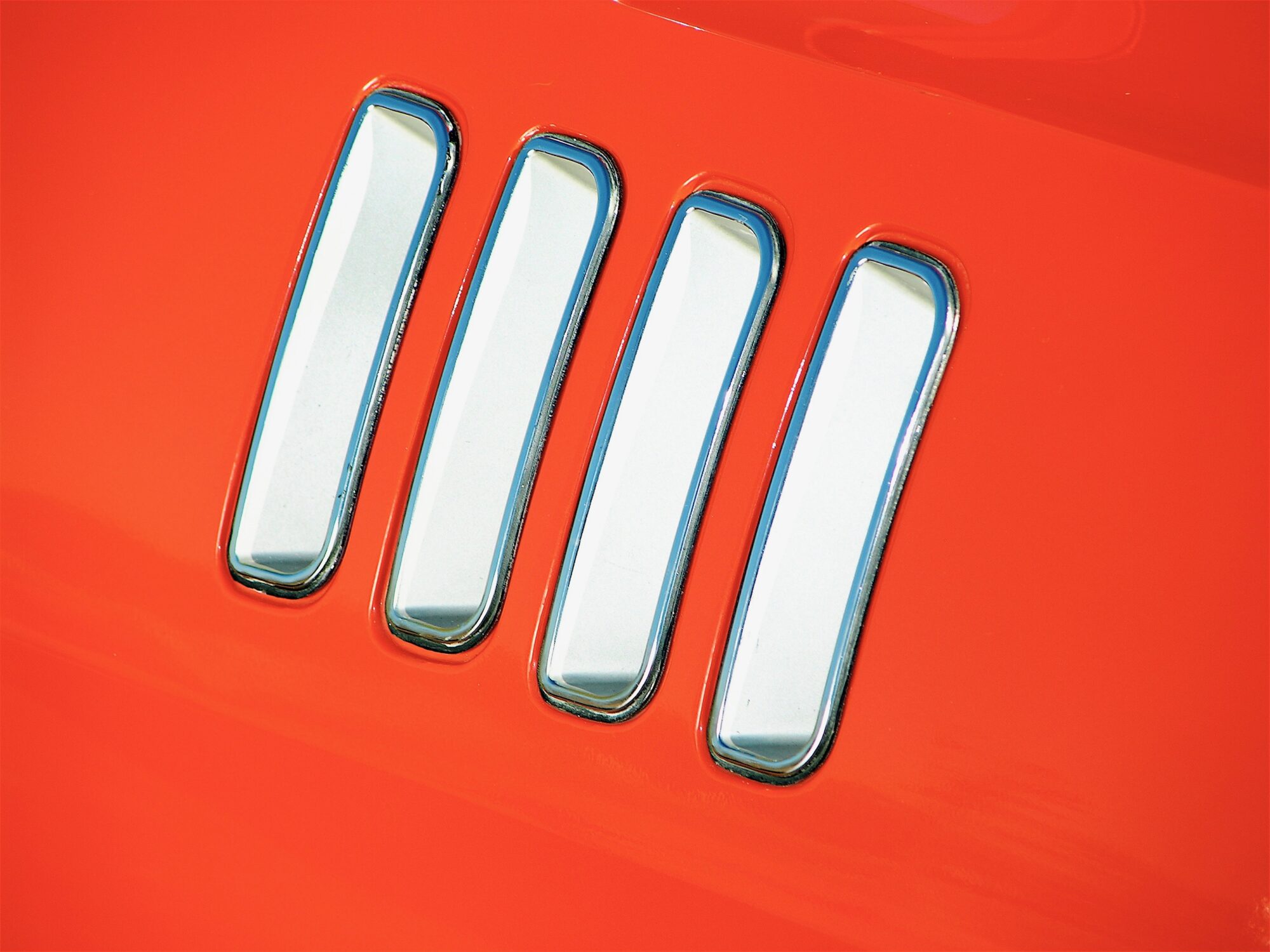
In order to give the 1971 ‘Cuda model of the Barracuda line its identity, the stylists gave it a different side view, with four “gills” were added on the front fenders. Of course to do with the car being named after a fish!
RETAINED WINDOW LABEL
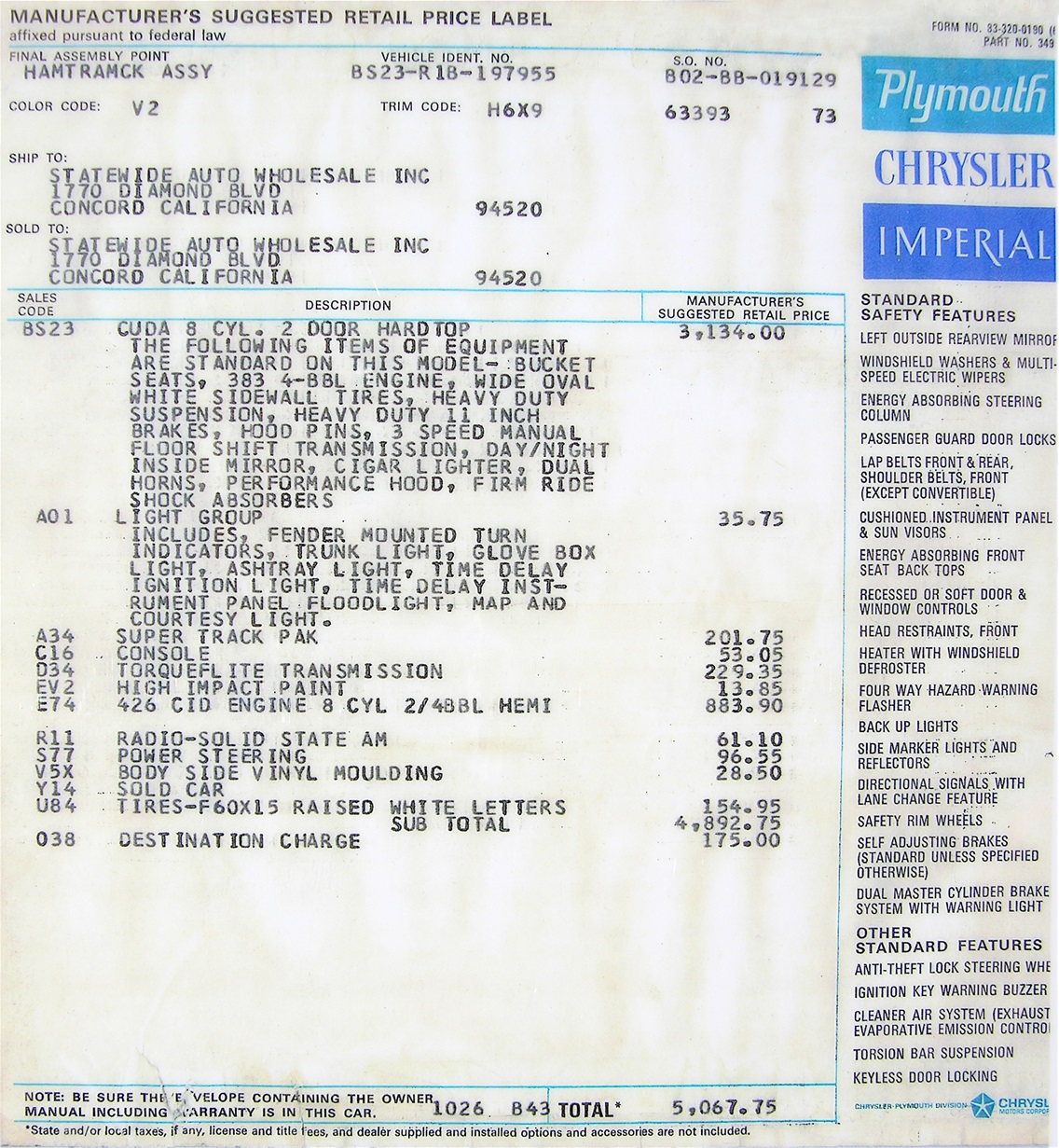
The Retail Price Label that was originally applied to the side window had been kept with the car, showing it was built at the Hamtramck Plant, shipped to California, and as a “sold” car (Y14) and with the $175.00 added as destination charge to the West Coast pushed the total price to $5,067.75.
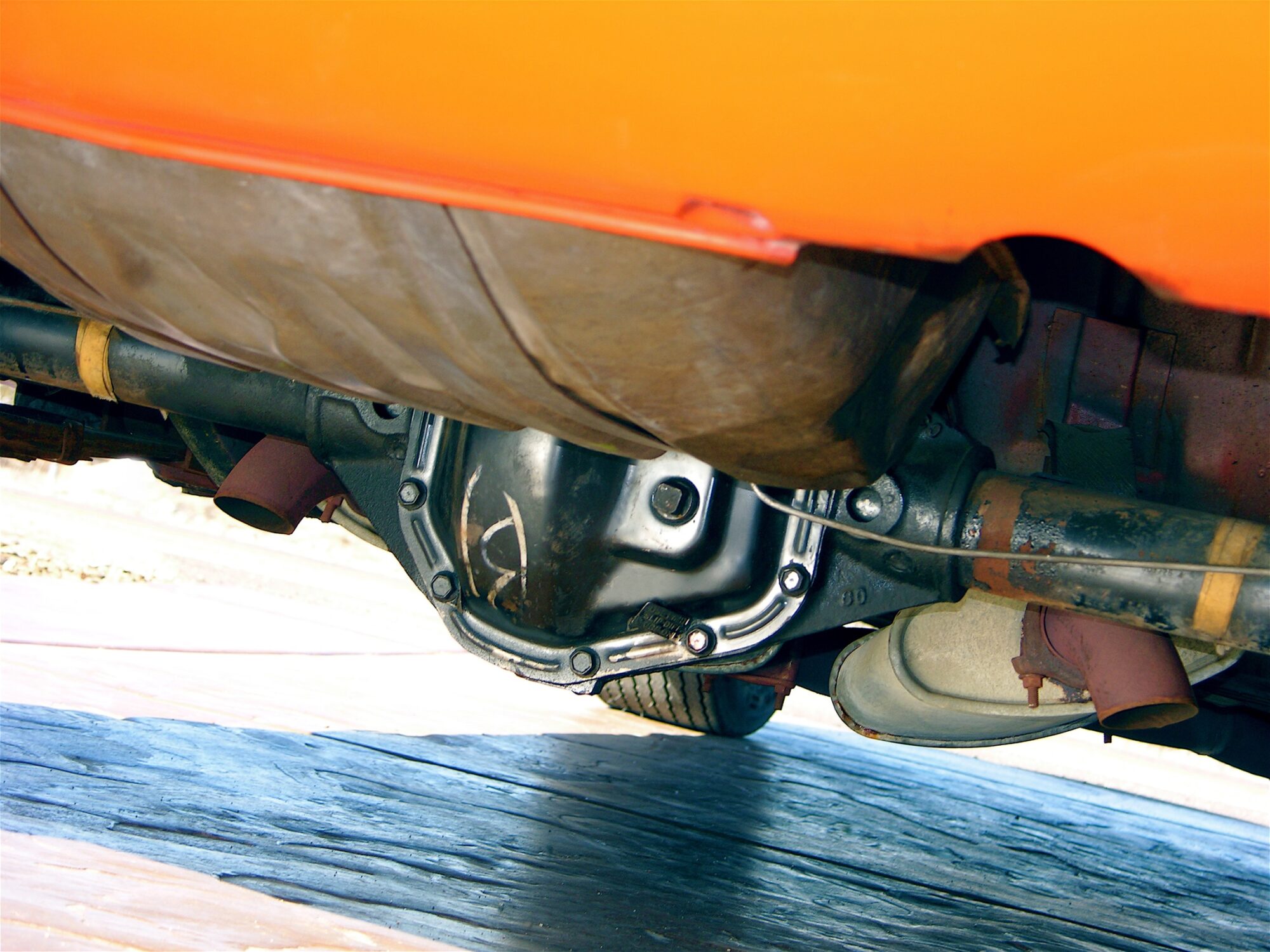
A34 option replaced the 8 3/4-inch rear axle with the big 9 3/4-inch Dana 60 and fitted with 4.10:1 ring and pinion.
DOUBLE FENDER TAGS
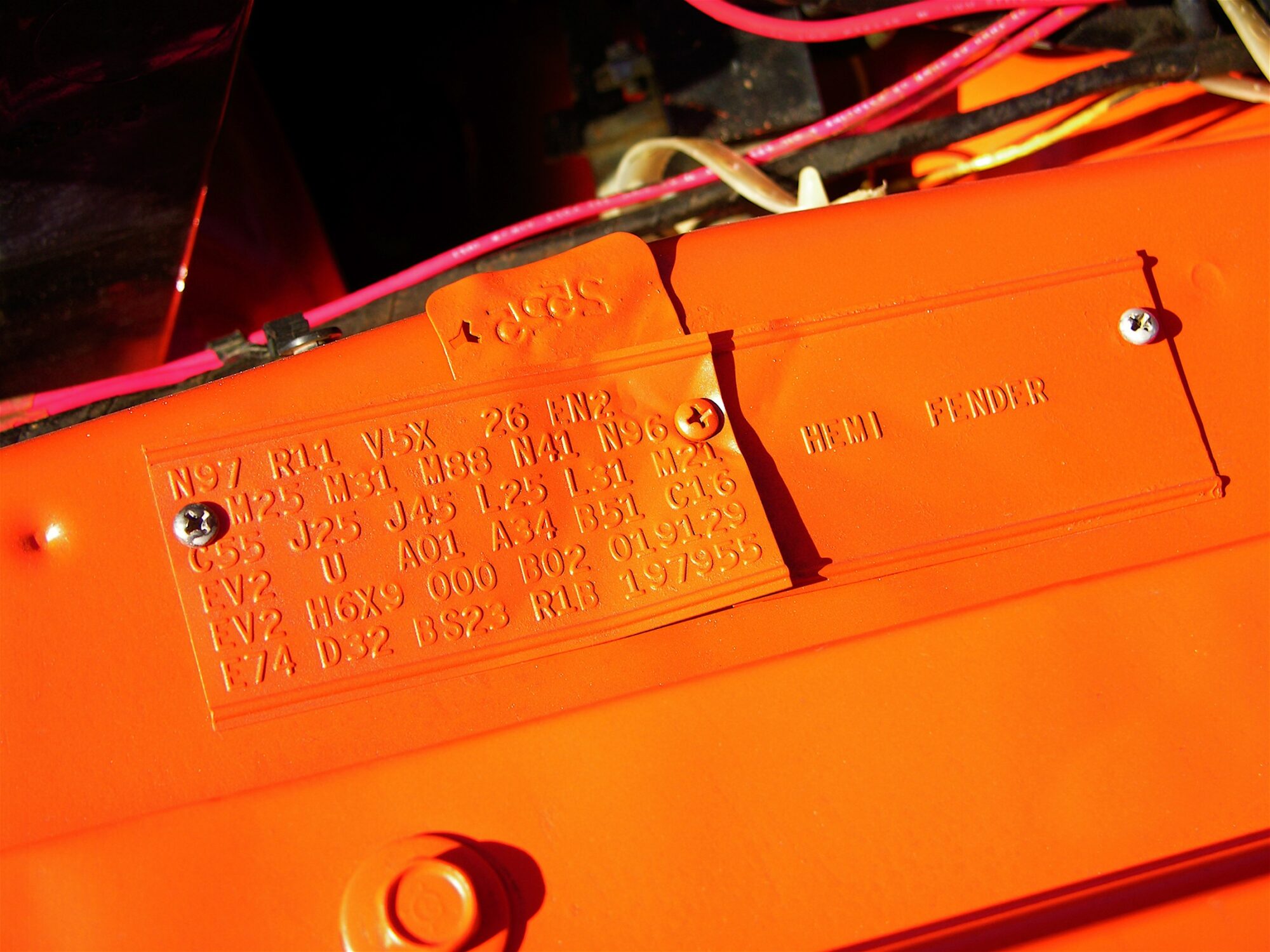
“E74” means HEMI engine, “A34” means Super Track Pac (Dana 60 4.10 ratio, power front disc brakes) and “EV2” means Tor-Red High Impact paint. It’s a “double fender tag” because the HEMI engine-powered ‘Cuda cars were fitted with specifically unique front fenders (rolled lip was modified for the F60-15 larger tires).
FACTORY BROADCAST SHEET
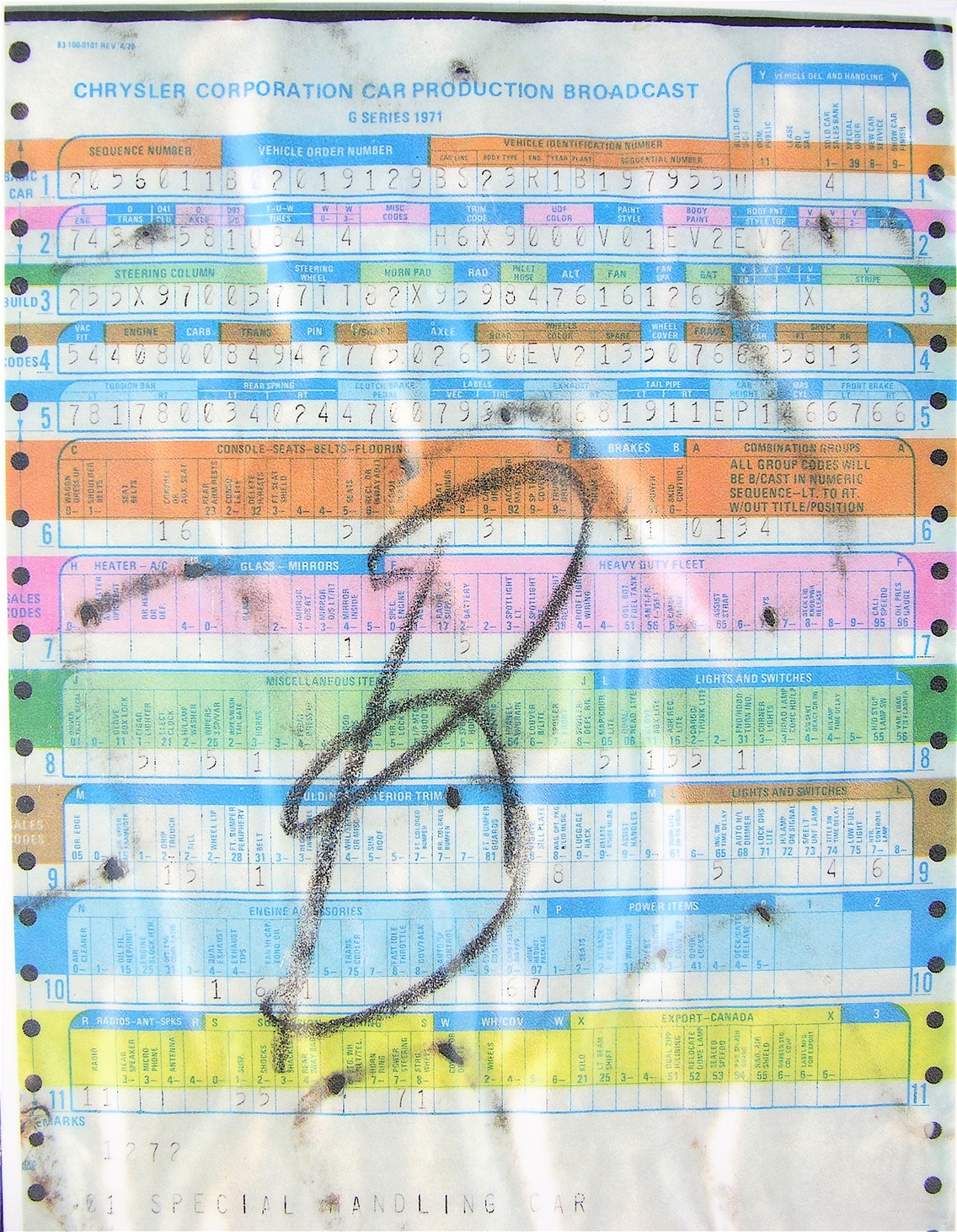
Found inside the rear seat springs was this “Broadcast Sheet” showing the VIN BS23R1B197955 (“R” signifies HEMI) with markings for Power Steering, Center Console, Radio along with the other factory-installed components. It’s also marked “V5X” which signifies the car originally had the optional “Body Side Vinyl Molding” (which were not included in the repaint). “Special Handling Car” relates to the HEMI-specific fenders.
SOX & MARTIN RACED ONE IN PRO STOCK
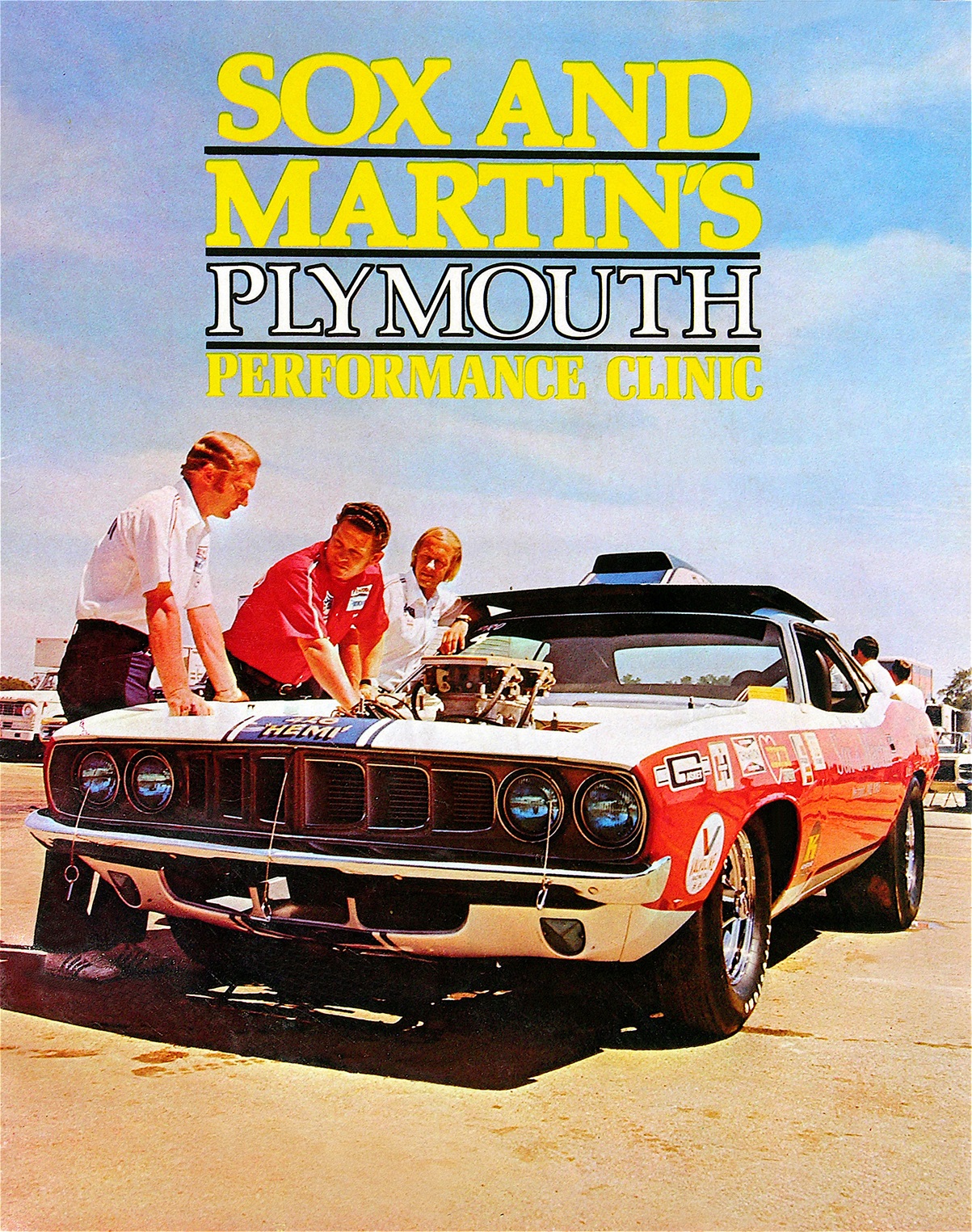
Ronnie Sox and Buddy Martin were the main Plymouth drag car team and when they were not out at drag strips racing (and doing lots of winning) with their 1971 HEMI ‘Cuda Pro Stocker, they would be doing special performance clinics at Chrysler-Plymouth dealerships nationwide.
“With the clinics, we were on the road 265 days a year,” said Sox in a 1989 interview. “The dealers really liked it and the feedback to Chrysler was great. I hated going to the clinics, but once I got there and got involved, I enjoyed the questions and stuff. You met a lot of nice people.” Pictured here is team manager Buddy Martin (left), ace wrench Jake King (center) and driver Ronnie Sox.
PLYMOUTH MAKES IT MARKETING
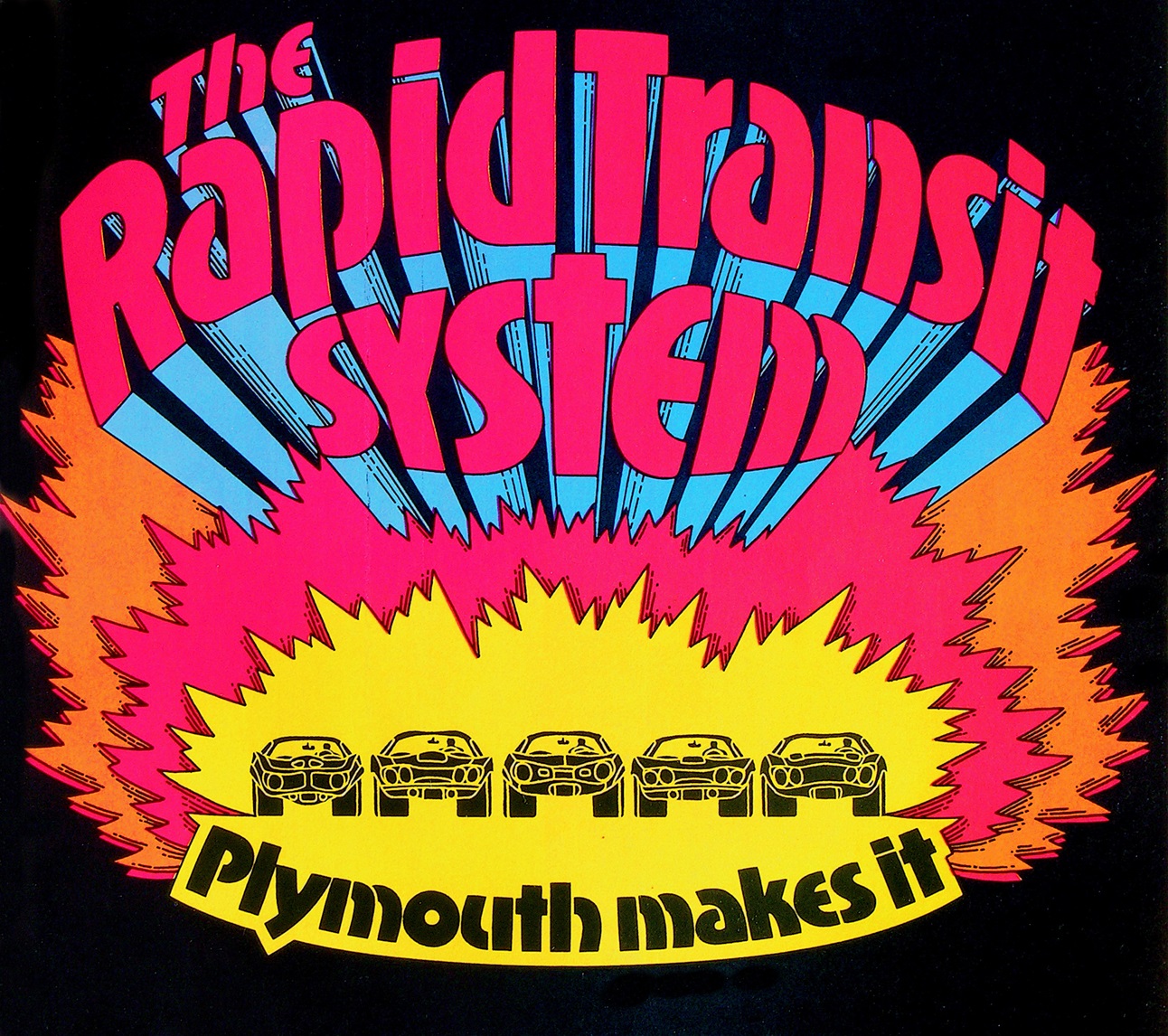
“The Rapid Transit System” was the theme for the five different performance car packages that Plymouth sold in 1971: ‘Cuda, GTX, Sport Fury GT, Road Runner and Duster 340. High-performance was alive and well at any Chrysler-Plymouth showroom!
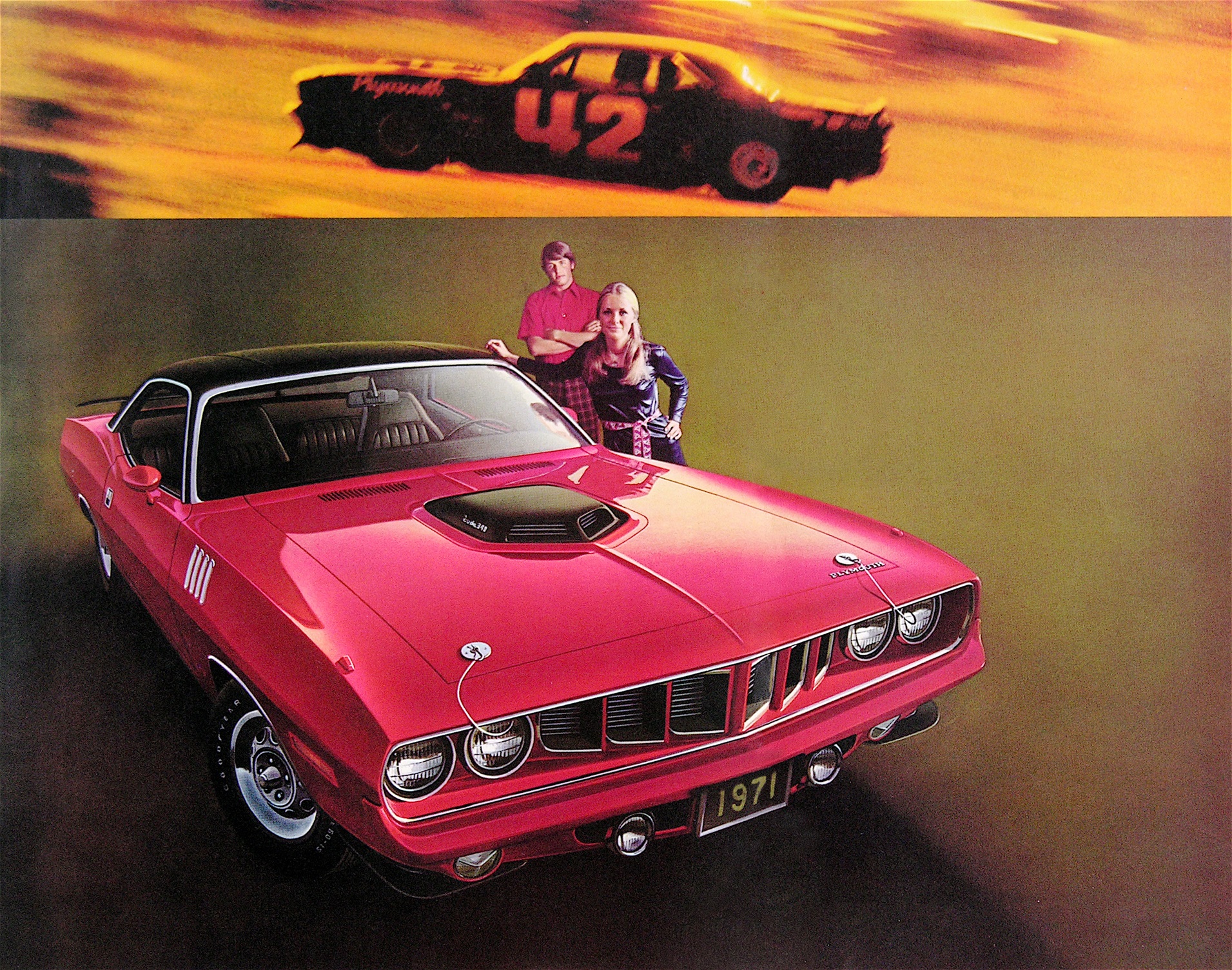
The dealer brochure for 1971 shows the Dan Gurney AAR ‘Cuda racer on top with a Shaker-equipped street ‘Cuda as the main image, done up with “A21” Elastomeric front bumper, “A45” spoiler package and “V1X” black vinyl roof.
Author: James Maxwell
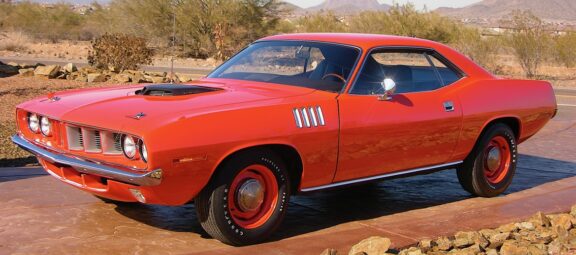
0 Comments